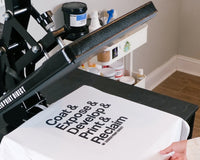Plastisol transfers are screen printed with plastisol ink on a plastisol transfer paper. We are frequently asked how to use this method of screen printing. First why use this method instead of traditional screen printing and how will this benefit your screen-printing business? Let's dive into how and why to use screen print transfers.
What Are Plastisol Transfers?

Plastisol Transfers are screen-printed designs that are printed on a unique heat transfer (release) paper rather than screen printing directly to a garment. Once the design is screen printed onto the sheet, the printed heat transfer sheets are ready to be transferred onto any garment (t-shirts, sweatshirts, hats, etc.) with a heat press. Below we walk you through how to press screen print transfers to your garment.
The Benefits of Plastisol Heat Transfers
- Printing on tough substrates
- For small print runs
- Live printing – No prior knowledge to client sizing
- Customization
We discuss in depth below.
While plastisol heat transfers won’t be the best fit for all your typical screen-printing jobs, various scenarios make plastisol heat transfers a better choice over traditional screen printing. Plastisol heat transfers are excellent for applying a thick, crisp print on top of substrates that are very tough to print on, such as baseball caps and athletics jerseys.
Plastisol heat transfers are also great for small print runs when you’re unsure of which items or sizes you will require. Let’s take live printing for example, if you decide to print on demand for customers, you can easily transfer artwork onto any size garment without pre-printing a lot of garments. By using the plastisol transfers you are saving money on garments that did not need to be printed on. Another cool way to utilize plastisol transfer is by using the same artwork on a variety of substrates. You can have pre-printed art and then when a customer decides to order you can print onto a blank t-shirt or jacket, saving the unused garments for future use.
In both models mentioned above, the plastisol heat transfers enable you to satisfy your customer without overprinting a huge volume of items that will sit unsold in your shop.
Plastisol heat transfers can also be a huge time saver when it comes to custom prints like jerseys. Let’s take sports jerseys for example. If you have pre-printed letters and numbers, you can customize t-shirts quickly without burning individual screens for each player’s name. Some print on demand companies use this style of printing for smaller custom orders.

These plastisol heat transfers give you the flexibility of printing on t-shirts, hats, sweatshirts, tote bags, koozies and so much more!
What Equipment is Required To Make Plastisol Heat Transfers?
- Emulsion
- Squeegee
- Plastisol Ink
- Frame
- Screen Printing Press
- Heat Press
- Transfer Paper
- Optional: Plastisol Transfer Powder
First, you will need the conventional screen-printing supplies: emulsion, squeegee, plastisol ink, inkjet film with artwork, an aluminum/wood frame, and a screen-printing press.
Beyond your conventional screen-printing equipment, you’ll need a few other supplies. You will need a heat press, heat transfer paper. We strongly suggest the use of plastisol transfer powder or foil adhesive additive when printing on 50/50 blends, polyester (any synthetic fibers.)

Benefits of Plastisol Transfer Powder: The powder will extend the life of the print and guarantees a smoother transfer onto desired substrate when its time to produce the final print. The powder also improves washability of the garment, earning you one happy customer 😊
Simplified Plastisol Screen Print Transfer Instructions:
For plastisol heat transfers, the artwork needs to be reverse printed onto the paper. The ink on the paper is then half cured, and then when it’s prepared to be positioned on a substrate, the paper is placed on the heat press and pressed with the heat set to approx. 320 degrees. The paper is pulled away, leaving the completely cured plastisol ink behind on the substrate.
Step by step: How to make screen print transfers
*Important to note before beginning: Artwork needs to be reverse printed onto the paper.
To print, make sure you have off-contact distance with your screen-printing press, commonly 1/16 of an inch.
We highly recommend a platen adhesive such as our Super Tack to keep your plastisol transfer paper from moving.
For a bright and clear print, apply your ink, flood the screen and then, pressing down with moderate pressure push or pull the squeegee across the screen.
Once the plastisol heat transfer has been created, you’ll need to partly cure/ gel the ink. This means heating your plastisol ink between 180- and 240-degrees Fahrenheit. I’m sure your next question is how long does it take to gel the ink? That is going to be dependent on the unit you are using, if you are familiar with the unit being used you should be able to tell when the ink is gelled not cured. Your plastisol heat transfer will then be ready to be applied to your product or stored for future use
There is one more step in the printing process should you choose to use a plastisol adhesive transfer powder or foil adhesive additive for synthetic fibers. Transfer powder improves wash durability and overall makes a much more durable print once transferred; we highly recommend including this next step.
If using the powder, print your artwork as stated previously however after the ink is printed flash the ink but do not fully cure the ink, it should be slightly wet. Next, get a bucket and pour transfer powder into the bucket, excess powder can be stored back into the container for future use. Using gloves take your slightly wet print and dip the transfer paper into the bucket and cover the entire printed area with powder. Run the powdered print through the drier to gel the ink between 180-240 degrees Fahrenheit. Gel the ink, do not fully cure the ink. Your plastisol heat transfer will then be ready to be applied to your product or stored for future use.

If using the foil adhesive additive, print the additive first onto the plastisol transfer paper and flash. Proceed with the printing steps as stated above.
*Please note that curing temps will vary depending on the type of ink you are using.
How Do You Apply the Plastisol Heat Transfer to your substrate?
There are 2 alternatives for application: hot-split transfers and cold transfers. Place substrate into a heat transfer press and position your plastisol heat transfer in the correct print placement. Next, how long to heat press screen print - with your heat transfer press set between 320-350 Fahrenheit, press the heat transfer onto the substrate for 10 to 12 seconds.
If you’re using hot-split transfer paper, you’ll instantly peel off the paper, which will slice the ink in two, inserting some on the substrate while leaving the remaining on the paper. This category of transfer gives a fluffier feel. With the help of a cold transfer, you’ll facilitate the substrate and the transfer paper to cool down rapidly for about 35- 40 seconds before removing the paper away. The whole plastisol transfer will stay on the shirt.
Pressure and timing are going to vary depending on the age and type of heat press you are using as well as the type of transfer paper. This is where you are really going to have to do some testing and see which combination and settings work best for you!
MISC Questions:
- What type of art can I make with Plastisol Transfers?
You can create anything you can print using traditional screen-printing methods.
How many different types of plastisol transfers are there?
1) Cold Peel: Applied with a heat press and removed once the transfer is cooled. Usually has a polished look.
2) Hot Peel: Applied with a heat press and removed instantly after pressing, while the transfer is however hot. Usually, it has more of a matte look.
3) Hot Split: Applied with a heat press and removed directly after pressing, while the transfer is hot. Some of the ink transfers to the t-shirt and some of them in on the plastisol heat transfer paper resulting in a "split". This is presumed to provide the final design the softest hand with a matte finish.
What category of Special Printing Methods Can Be Performed with Plastisol Transfers
Numerous of the specialty printing procedures done by conventional screen printers can be performed with custom plastisol transfers. This comprises (but is not limited to): puff printing, glitter printing, foil printing, colorless screen printing, sparkle printing, etc.
What Is the Quality of Plastisol Transfers?
Out of inkjet-printed transfers, vinyl transfers, laser printed transfers, and opaque transfers, plastisol transfers have a more impressive print quality and a more promising durability.
Can you screen print iron on transfers?
This is a grey area. It can be done however we don’t recommend it as you have no way of controlling the temperature of the iron and the surface area might not be the appropriate size to cover the artwork. This leaves a lot of error for the plastisol print fully curing on the new garment and transferring over cleanly.
Let's Talk
Remember, we are here to help! Drop a comment below or email our support team at info@screenprintdirect.com








1 comment
Willie Hughes
Just trying to join and see how this work.